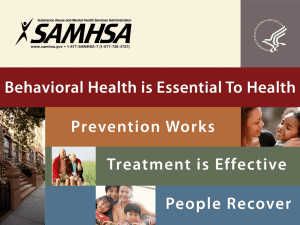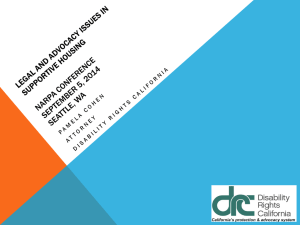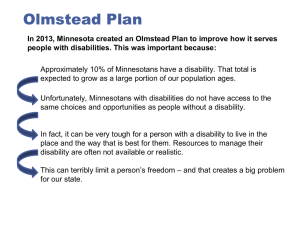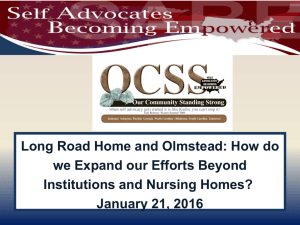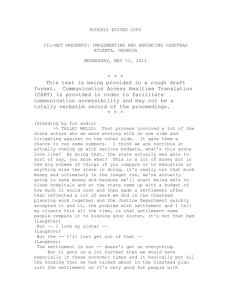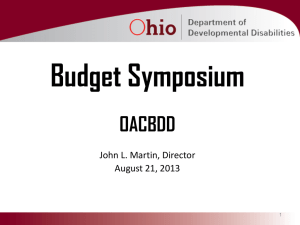Community-Integrated Personal Assistance Services and Supports
advertisement
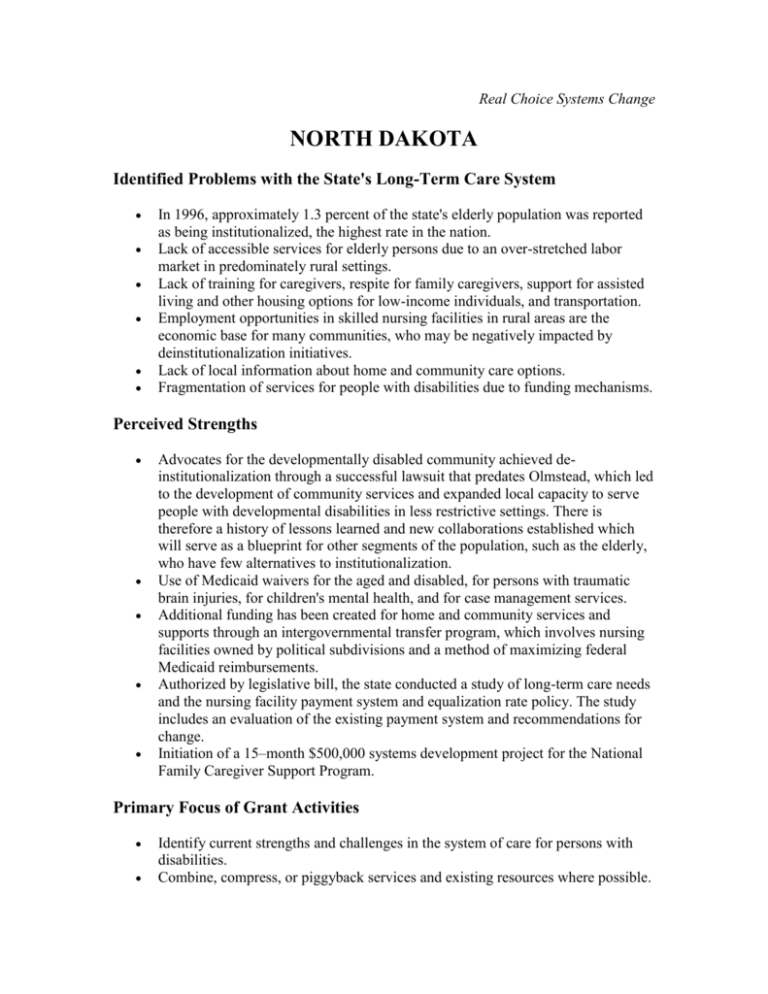
Real Choice Systems Change NORTH DAKOTA Identified Problems with the State's Long-Term Care System In 1996, approximately 1.3 percent of the state's elderly population was reported as being institutionalized, the highest rate in the nation. Lack of accessible services for elderly persons due to an over-stretched labor market in predominately rural settings. Lack of training for caregivers, respite for family caregivers, support for assisted living and other housing options for low-income individuals, and transportation. Employment opportunities in skilled nursing facilities in rural areas are the economic base for many communities, who may be negatively impacted by deinstitutionalization initiatives. Lack of local information about home and community care options. Fragmentation of services for people with disabilities due to funding mechanisms. Perceived Strengths Advocates for the developmentally disabled community achieved deinstitutionalization through a successful lawsuit that predates Olmstead, which led to the development of community services and expanded local capacity to serve people with developmental disabilities in less restrictive settings. There is therefore a history of lessons learned and new collaborations established which will serve as a blueprint for other segments of the population, such as the elderly, who have few alternatives to institutionalization. Use of Medicaid waivers for the aged and disabled, for persons with traumatic brain injuries, for children's mental health, and for case management services. Additional funding has been created for home and community services and supports through an intergovernmental transfer program, which involves nursing facilities owned by political subdivisions and a method of maximizing federal Medicaid reimbursements. Authorized by legislative bill, the state conducted a study of long-term care needs and the nursing facility payment system and equalization rate policy. The study includes an evaluation of the existing payment system and recommendations for change. Initiation of a 15–month $500,000 systems development project for the National Family Caregiver Support Program. Primary Focus of Grant Activities Identify current strengths and challenges in the system of care for persons with disabilities. Combine, compress, or piggyback services and existing resources where possible. Improve access to information about home and community service options. Demonstrate cost-effectiveness of creative changes in service delivery through pilot projects. Goals, Objectives, and Activities Overall Goal. Create a consumer-driven system of services for people with disabilities and long-term illnesses. Goal. Use meta-analysis to compile and analyze assessments already completed or underway, in order to target systems change efforts appropriately. Objectives/Activities Collect and analyze data, and prepare a report reviewing current services and identified needs of persons with disabilities targeted to their community, advocates, service providers, and the Department of Human Services. The information will be used to inform and shape direction for services delivery and policy. Incorporate meta-analysis into the development of RFPs for the pilot projects. Goal. Implement and monitor five pilot projects designed to assess how long-term care systems can be changed. Objectives/Activities Person-Centered Care project: Examine how to enhance quality of life in the institutional setting with the aim of changing the culture within the institution, and investigate the possibility of some individuals transitioning into less restrictive settings. Financial Pooling Model: Based on the Good Samaritan Society model, encourage individuals to address future needs by pooling resources from public funds, private insurance, and savings to pay for long-term care and supportive services. Living in Place project: Explore the current status of individuals participating in a pilot project to find out how many people could stay in their homes with a small amount of support, such as adaptive equipment, with the aim of looking at the Medicaid budget to provide support to other individuals in the future. Cultural project: Research and support American Indian or other cultural group preferences to live at home or in congregate settings with a focus on safety and culturally congruent service delivery. Simplified Informational Access to Services project: align existing information and referral resources by building partnerships among existing services to assure comprehensive databases, cross referrals, and closer collaboration. Key Activities and Products A white paper on the current system and meta-analysis of current studies of the systems of care. Develop requests for proposals for innovative projects in rural communities based upon a review of research and service delivery currently underway. Demonstrate through pilot projects the cost-effectiveness of creative changes in service delivery, including simplified access to services, consumer involvement in development and management of services, and consumer-directed fiscal planning for services. Consumer Partners The Governor's Commission on Olmstead includes five consumers/advocates, member(s) from the Protection and Advocacy Project, three legislators, and representatives from the Governor's Office, Attorney General's Office, and the Department of Human Services. The Commission reports to the Governor's office and have been involved from the beginning of North Dakota's Olmstead initiative. Consumer Partners and Consumer Involvement in Planning Activities In March 2002, the Governor's Commission on Olmstead sponsored 20 focus groups across the state to gather more information about perceived gaps in services. The groups commenced with a brief overview of the Olmstead decision followed by a request for identification of the major barriers to services in the community and suggestions to improve the system of services. Issues that were identified included transportation, housing, and the need for more services in frontier areas. Consumers from the local community participated on the grant-writing team. Some of the team members provided input for the outline and direction of the grant, others read for clarity and accurateness of the content, others acted as "Devil's Advocate" in looking at the budget and direction of the grant, others reviewed current comments from consumers about the needs across the state to ensure those needs were addressed. Consumer Partners and Consumer Involvement in Implementation Activities Consumers are expected to be involved in the planning, development and implementation of all projects funded by the grant. Public Partners Subdivisions of the Department of Human Services (the lead agency), including Medicaid, Disability Services, Aging Services, Children's Special Health Services, and Children and Family Services. Mental Health and Substance Abuse Services. Governor's Commission on Olmstead. Protection and Advocacy Project. Private Partners and Subcontractors The Arc. AARP. Mental Health Association in North Dakota. The Evangelical Lutheran Good Samaritan Society. Independence, Inc. Western Sunrise Inc. Public and Private Partnership Development/Involvement in the Planning Phase Public Input from public partners was solicited throughout the grant development process. The public partners identified existing services, perceived gaps in services, gave feedback on the grant application, and reviewed written submissions for clarity and feasibility. A staff person from the Division of Mental Health and Substance Abuse Services was the lead person on the grant-writing team. The team also included a staff member of the Division of Aging Service, members of the Olmstead Commission, and staff from the Protection and Advocacy Project. Some of the team members provided input for the outline and direction of the grant, others read for clarity and accurateness of the content, others acted as "Devil's Advocate" in looking at the budget and direction of the grant, others reviewed current comments from consumers about the needs across the state to ensure those needs were addressed. Private Input was solicited from the Arc, AARP, and other advocates at the draft stage and their comments and suggestions were incorporated into the final application. Public and Private Partnership Development/Involvement in Implementation Public The public agencies will continue to provide consultancy and resources to the pilot projects. Coalitions, memorandums of understanding and other collaborative efforts will come forth as the proposals for the pilots are written. Private Mental Health Association in North Dakota will implement the Simplified Informational Access to Services project. Evangelical Lutheran Good Samaritan Society will implement the Financial Pooling project. Independence, Inc. and Western Sunrise Inc. will implement the Living in Place project. Oversight/Advisory Committee The Governor's Commission on Olmstead will oversee the project. The oversight committee will receive reports from the grant coordinator on the progress of each of the projects and in turn will report to the Governor's office. Formative Learning and Evaluation Activities Quarterly progress reports from the pilots will be submitted to the grant coordinator who will in turn submit a quarterly report to the oversight committee to evaluate how well the Real Choice project is meeting consumer needs and whether or not it will produce sustainable change in the system. The reports will also indicate barriers, lessons learned and suggested changes in direction in terms of project strategies. The Committee will discuss any changes and provide the final decision regarding changes in the direction of grant activities. Evidence of Enduring Change/Sustainability The Real Choice Grant aims to create a paradigm shift among advocates, providers, and the wider community by increasing awareness of the Olmstead decision through the use of flyers, outreach and presentations. Each applicant for the pilot projects will be required to submit a plan to identify products and methods that will be sustainable. Successful applicants will be able demonstrate how their projects will improve the lives of persons with disabilities and how those projects can be incorporated into the existing system. While the pilot projects will work with sample populations and are geographically and time limited, specific tasks, such as improved access to information, will endure beyond the grant period because all of the existing 1–800 numbers will be integrated. Investigating the need for community supports among elderly persons and Native Americans, such as adaptive equipment and services, will enable future planning in the Medicaid budget to help people remain in their homes. Geographic Focus Rural areas of the state, exact location depending on the five individual pilot projects selected.
